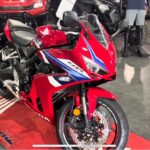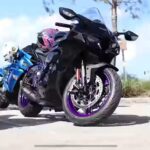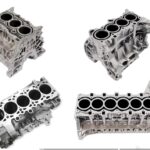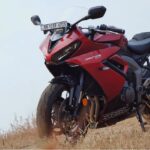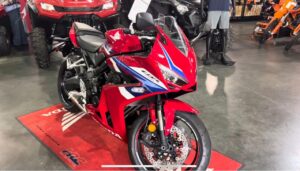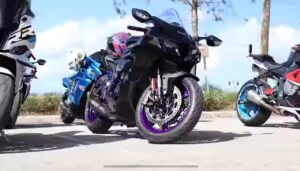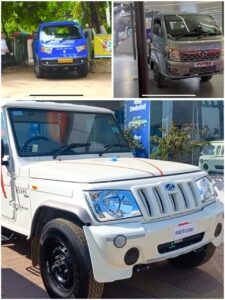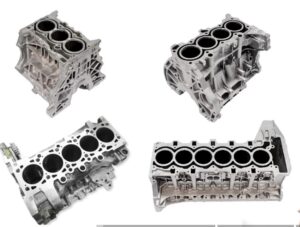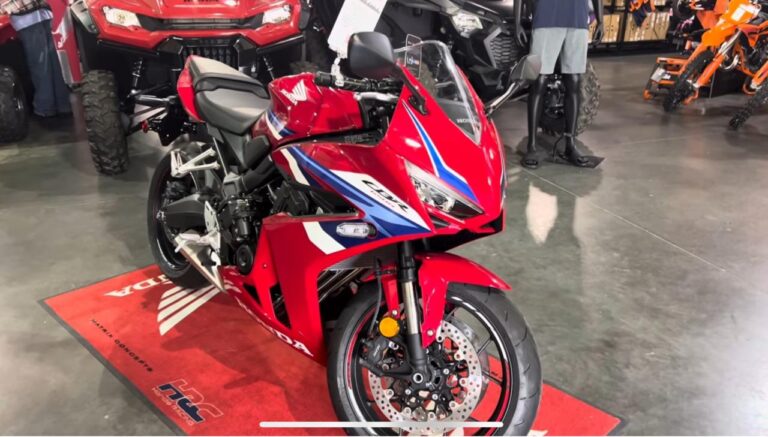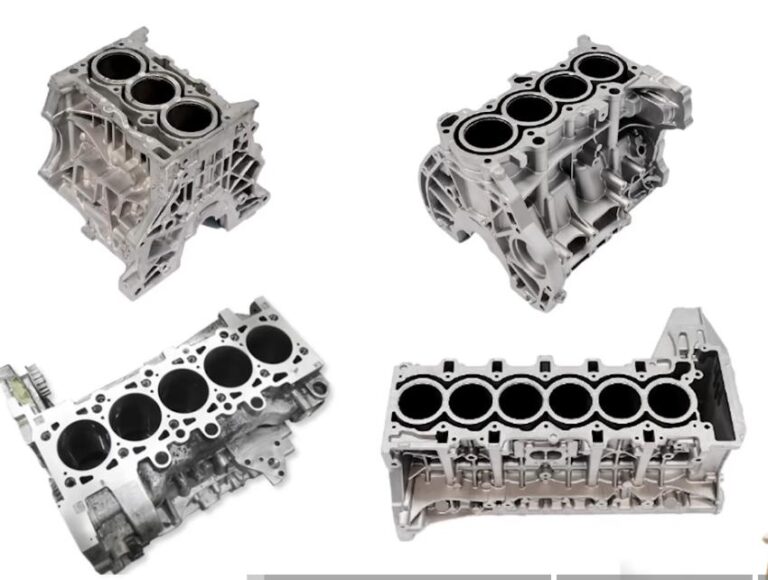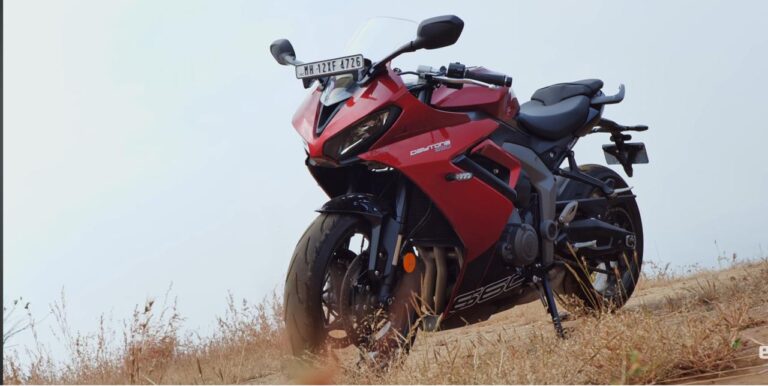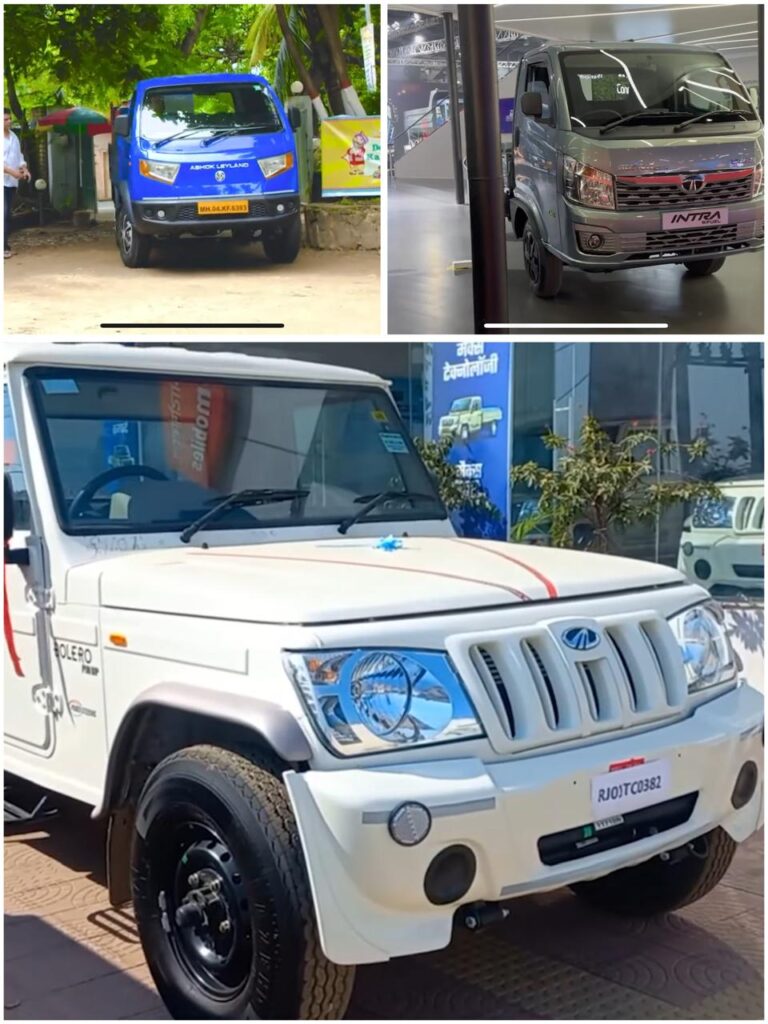When considering a best entry level superbike in India, beginners often seek a combination of performance, affordability, comfort, and reliability. Superbike ownership requires a balance of handling power, style, and ease of use, especially for those new to high-performance motorcycles. While superbikes can come in a variety of engine capacities, a 600cc to 900cc range is often seen as ideal for beginners who want to experience superbike thrills without overwhelming themselves with excessive power.
Here are some of the best entry-level superbikes for beginners in India (2025):
1. Triumph Trident 660 – Specifications and Features

Engine and Performance
- Engine Type: 660cc, Inline-3, Liquid-Cooled, DOHC
- Power Output: 81 PS (59 kW) @ 10,250 rpm
- Torque: 64 Nm @ 6,250 rpm
- Bore x Stroke: 74 mm x 51.1 mm
- Compression Ratio: 11.3:1
- Transmission: 6-speed constant mesh, with assist and slipper clutch
- Cooling: Liquid cooling
- Fuel System: Ride-by-wire with Electronic Fuel Injection
- Top Speed: Approx. 200 km/h (depending on conditions)
Dimensions and Weight
- Overall Length: 2,090 mm
- Overall Width: 780 mm
- Overall Height: 1,100 mm
- Wheelbase: 1,410 mm
- Ground Clearance: 145 mm
- Seat Height: 810 mm
- Kerb Weight: 189 kg (approx.)
- Fuel Tank Capacity: 14 liters
- Reserve Fuel Capacity: 3.2 liters (approx.)
Suspension and Brakes
- Front Suspension: 41mm USD (Upside-Down) forks, with adjustable preload
- Rear Suspension: Monoshock, adjustable preload
- Front Brakes: Dual 310mm discs with Nissin 2-piston sliding calipers
- Rear Brakes: 255mm disc with single-piston caliper
- Braking System: Dual-channel ABS (Anti-lock Braking System)
- Wheel Size: 17-inch front and rear
- Tyre Size:
- Front: 120/70-ZR17
- Rear: 180/55-ZR17
Electronics and Features
- Digital Instrument Cluster: Full-color TFT display with gear position indicator, tachometer, trip computer, fuel gauge, and clock.
- Riding Modes: Road, Rain, and Sport modes, which alter the throttle response and traction control for different conditions.
- Triumph Traction Control: Adjustable traction control system for better control in various weather conditions, particularly on wet or slippery roads.
- LED Lighting: Full LED headlights, tail light, and turn indicators for improved visibility and modern appeal.
- Quickshifter (Optional): Some models come equipped with a quickshifter for smoother and quicker gear shifts, especially useful for spirited riding.
- Assist and Slipper Clutch: Reduces clutch effort and prevents rear-wheel lockup during aggressive downshifting, improving control and smoothness.
Performance and Handling
- Engine Performance: The 660cc inline-3 engine in the Trident offers a good balance of power and torque, providing enough grunt for a fun ride without being overwhelming for newer or less experienced riders. With 81 PS (59 kW), the bike delivers a healthy amount of power for everyday use, while the 64 Nm of torque ensures a strong midrange and decent top-end performance.
- Acceleration: The Trident 660 can go from 0 to 100 km/h in about 4.5-5 seconds, which is impressive for a middleweight naked bike. Its quick throttle response and smooth power delivery make it an enjoyable ride for both relaxed commuting and spirited weekend riding.
- Handling: The lightweight nature of the Trident (around 189 kg) makes it highly maneuverable in both city traffic and twisty roads. The adjustable suspension (preload for both front and rear) allows the rider to set up the bike for personal preference or specific riding conditions. The bike’s low center of gravity and responsive chassis make it feel agile in corners and easy to control in tight situations.
- Braking: With dual 310mm discs at the front and ABS, the braking system of the Trident offers strong stopping power and safety. The Nissin calipers provide a good feel at the lever, while the dual-channel ABS ensures that you can stop with confidence in various riding conditions, even in wet weather.
Comfort and Ergonomics
- Riding Position: The Triumph Trident 660 offers an upright and comfortable riding position, making it a good choice for everyday riding as well as longer trips. The seat height of 810mm is manageable for most riders, though shorter riders may find it a bit high.
- Seat and Comfort: The seat is wide and well-padded, offering decent comfort for a naked bike. While it’s not as plush as a touring seat, it’s certainly adequate for long rides or daily commuting.
- Handlebars and Foot Pegs: The handlebars are positioned for a relaxed yet sporty riding posture, and the footpegs are not overly aggressive, which contributes to comfort during longer stints in the saddle.
Key Highlights of the Triumph Trident 660
- Inline-3 Engine: The 660cc inline-3 engine is unique in the middleweight naked bike segment, offering a distinct character with smooth power delivery and a more torquey midrange compared to an inline-4.
- Modern Electronics: Riding modes, traction control, and a TFT instrument cluster give it an edge over some competitors, making it a well-equipped, modern machine.
- Great Handling: With its lightweight build, adjustable suspension, and sharp steering geometry, the Trident is an easy bike to handle, whether you’re in traffic or carving through corners.
- Stylish and Practical: The Triumph Trident has a modern, minimalistic design that appeals to a wide range of riders, while its practical features make it a great option for commuting, weekend rides, or beginner riders looking to step up from smaller motorcycles.
- Affordable Price: The Trident 660 is priced competitively compared to its competitors in the middleweight naked bike segment, offering good value for money with its premium features and performance.
Pros of the Triumph Trident 660
- Unique Engine: The 660cc inline-3 offers a distinctive feel compared to typical inline-4 or V-twin engines.
- User-Friendly: Easy to ride, especially for new or intermediate riders, thanks to its manageable power and ergonomics.
- Modern Tech: Features like traction control, ride modes, quickshifter (on some variants), and LED lighting make the Trident feel up-to-date with modern expectations.
- Comfort: Comfortable for daily use with a relaxed riding position and manageable seat height.
- Great Handling: Light and agile, with a solid suspension setup for both city and spirited riding.
- Attractive Price: A strong competitor in its class for the value it offers in terms of performance, technology, and style.
Cons of the Triumph Trident 660
- Limited Top-End Power: While the 81 PS (59 kW) engine is strong, some riders might find it lacking compared to the more powerful inline-4 competitors like the Yamaha MT-07 or Kawasaki Z650 in terms of outright top-end performance.
- Not as Refined as Larger Triumphs: The Trident is aimed at a more affordable market, so it may lack some of the higher-end features or finishes that you’d find on larger Triumph motorcycles like the Street Triple R or Speed Triple.
- Performance Options: It may not have the same performance-oriented features (like premium suspension components or advanced electronics) found on some sportier alternatives.
2. Kawasaki Z900
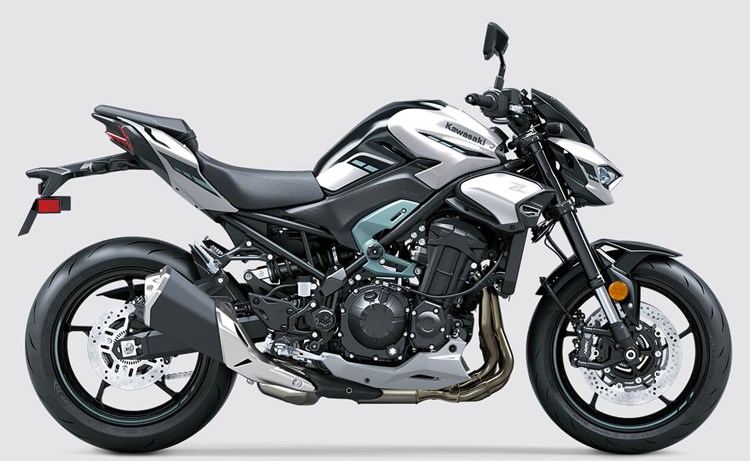
- Engine: 948cc, in-line 4, Liquid-Cooled
- Power: 123.64 bhp @ 9,500 rpm
- Torque: 98.6 Nm @ 7,700 rpm
- Transmission: 6-speed
- Top Speed: 240 km/h (approx.)
- Weight: 212 kg (kerb)
- Price: ₹9.38 lakh ex-showroom
Why it’s great for beginners:
Features
- Digital Instrumentation: Full LCD display with a gear position indicator, fuel gauge, trip computer, and tachometer.
- Riding Modes: Power Mode (Low and Full), to adjust the power delivery according to rider preference.
- Kawasaki Traction Control (KTRC): 2-mode traction control system that enhances safety and stability, especially in wet conditions.
- LED Lighting: LED headlights and tail light for improved visibility and aesthetics.
- Ergonomics: Slightly aggressive riding position but still comfortable for long rides. The handlebar offers a neutral feel for both city riding and highway cruising.
- Assist and Slipper Clutch: Aids in smoother downshifts and reduces clutch lever effort, which is a great feature for beginners moving up from smaller bikes.
Performance and Handling
- Acceleration: With the inline-four engine delivering 125 PS, the Z900 accelerates quickly and smoothly. It’s powerful enough to provide thrilling performance while still being manageable for experienced riders.
- Top Speed: The top speed is around 220 km/h, making it capable of highway cruising and spirited rides.
- Handling: The Z900 has a well-balanced chassis, making it agile around corners and stable at high speeds. Its lightweight design (for its class) and responsive suspension system make it an enjoyable bike for riders who appreciate tight turns and quick handling.
Safety Features
- Dual-Channel ABS: The ABS system helps prevent wheel lockup during hard braking, especially in wet or slippery conditions.
- Kawasaki Traction Control (KTRC): The two-mode traction control system reduces the risk of losing grip, especially in low-traction situations (e.g., wet or gravel roads).
Key highlights of CBR 650R
- Performance: The Z900‘s 948cc inline-four engine provides excellent power for both spirited street riding and highway cruising. It’s the kind of bike that offers impressive performance without being overly aggressive for experienced riders.
- Handling: The bike is very agile, and the low weight makes it fun to maneuver in urban traffic and on twisty roads. With good suspension and braking components, it handles well in various riding conditions.
- Technology: It comes equipped with Kawasaki’s Traction Control System (KTRC) and adjustable Power Modes, making it adaptable to different riding environments and rider preferences.
- Design: The Z900 has a minimalist, aggressive design, which is a hallmark of the Z-series. Its sharp lines, muscular build, and LED lighting make it stand out in terms of aesthetics.
- Comfort: Though it’s a sportbike, the Z900 offers a reasonable amount of comfort for daily riding, with a relatively relaxed riding position compared to full-blown sportbikes.
- Versatility: While it’s more performance-oriented than cruiser bikes, the Z900 is still comfortable enough for long rides and suitable for different riding scenarios, including touring and daily
Pros of the Kawasaki Z900
- Incredible Power: The inline-four engine offers smooth power delivery and great acceleration.
- Nimble and Agile: Despite its engine size, the bike is easy to maneuver in tight city traffic or on twisty roads.
- Top-Notch Features: Advanced electronics, including traction control, adjustable power modes, and ABS.
- Excellent Braking: Dual-disc brakes with powerful radial-mounted calipers, along with ABS, enhance stopping power and safety.
- Impressive Styling: The bike’s aggressive, modern styling with a minimalist approach is a big draw.
Cons of the Kawasaki Z900
- Weight: At 210 kg, the Z900 is not the lightest bike in its class, which may be a consideration for shorter or less experienced riders.
- Seat Height: The 820 mm seat height may be a bit high for shorter riders, which could affect comfort and confidence when stopping.
- Fuel Economy: The fuel efficiency is not exceptional, with mileage hovering around 14-17 km/l, depending on riding conditions.
3. Honda CBR650R 2025 – Specifications and Features

Engine and Performance
- Engine Type: 649cc, In-Line 4, Liquid-Cooled, DOHC
- Power Output: 93.8 PS (69 kW) @ 11,500 rpm
- Torque: 64 Nm @ 8,500 rpm
- Transmission: 6-speed constant mesh, with assist and slipper clutch
- Cooling: Liquid cooling
- Top Speed: 250 km/h (depending on conditions)
Why it’s great for beginners:
Features
- LCD Instrument Cluster: Includes a gear position indicator, tachometer, speedometer, fuel gauge, and trip computer. It’s clear and easy to read.
- Riding Modes: The Honda CBR650R does not feature complex electronic modes like higher-end bikes, but its throttle response is still quite refined and predictable.
- Assist and Slipper Clutch: Reduces the chance of wheel hop and improves downshifting performance, especially during aggressive riding.
- LED Lighting: Full LED lighting for improved visibility, including a sharp-looking LED headlamp, tail lamp, and indicators.
- Adjustable Suspension: Front and rear suspension are adjustable for preload, allowing riders to customize the setup for various riding conditions.
Performance and Handling
- Engine Performance: The 649cc in-line four engine provides a good balance of power and torque. It’s strong enough to make highway cruising and high-speed rides enjoyable but remains manageable for mid-range sportbike riders.
- Acceleration: With 93.8 PS (69 kW) at its disposal, the CBR650R accelerates quickly, with smooth, linear power delivery and a screaming high-revving engine that peaks at 11,500 rpm.
- Handling: The CBR650R’s chassis is well-balanced, offering impressive agility and stability. Its 17-inch wheels, lightweight frame, and solid suspension setup make it a responsive and fun motorcycle, both for everyday use and spirited riding.
- Braking: The dual 310mm front discs with ABS provide excellent stopping power, and the rear brake is equally capable for everyday use.
Comfort and Ergonomics
- Riding Position: The CBR650R offers a sportier riding position with slightly aggressive ergonomics. The clip-on handlebars and slightly forward-set footpegs are well-suited for track-style riding but still relatively comfortable for daily street use.
- Seat Height: At 810mm, the seat height is accessible to a broad range of riders, though it may feel a bit tall for those with shorter inseams.
- Fuel Tank Design: The 15.4-liter fuel tank is designed for long-distance touring, offering a decent range and a relatively narrow profile for improved rider comfort.
Key Highlights and Reasons to Choose the Honda CBR650R
- High-Revving Inline-4 Engine: The CBR650R‘s 649cc, inline-four engine provides a thrilling riding experience, offering both performance and refinement.
- Well-Balanced Handling: The lightweight frame and adjustable suspension deliver a well-rounded, agile, and stable riding experience, whether on winding roads or the track.
- Comfortable Riding Position: While it’s sportier, the ergonomics are less aggressive than some of the more extreme supersport bikes, making it a better option for longer rides.
- Modern Design: The sharp, aggressive styling of the CBR650R gives it a premium, modern look, and the full LED lighting enhances visibility and aesthetics.
- Safety Features: ABS, assist and slipper clutch, and the Honda Selectable Torque Control (HSTC) system enhance safety and improve the riding experience in a variety of conditions.
- Reliability and After-Sales: Honda has a great reputation for reliability and after-sales service, making the CBR650R a solid investment for those seeking long-term ownership.
Pros of the Honda CBR650R
- Incredible Engine Performance: The high-revving, smooth inline-four engine is one of the key highlights, offering both fun and refinement.
- Balanced Chassis and Suspension: Excellent handling, stability, and comfort in everyday riding and on twisty roads.
- Attractive Design: The aggressive styling with sleek bodywork and LED lighting makes the CBR650R look sharp and modern.
- Advanced Features: Comes with a slipper clutch, ABS, and HSTC, enhancing safety and usability.
- Good Comfort for Sport Riding: The riding posture is sporty yet comfortable enough for longer rides or commutes.
Cons of the Honda CBR650R
- Not Ideal for Beginners: While the CBR650R is not as aggressive as some of the higher-capacity bikes, its sporty nature and powerful engine may still be challenging for complete beginners.
- Seat Height: The 810mm seat height might be tall for shorter riders.
- Lack of Advanced Electronics: While the CBR650R has some electronics, it’s not as high-tech as more premium bikes like the CBR1000RR or Yamaha YZF-R1.
- Price: The CBR650R is on the higher end of the spectrum for its class, and its price may be a bit steep for some buyers.
4. Kawasaki ZX-6R (2025) – Specifications and Features
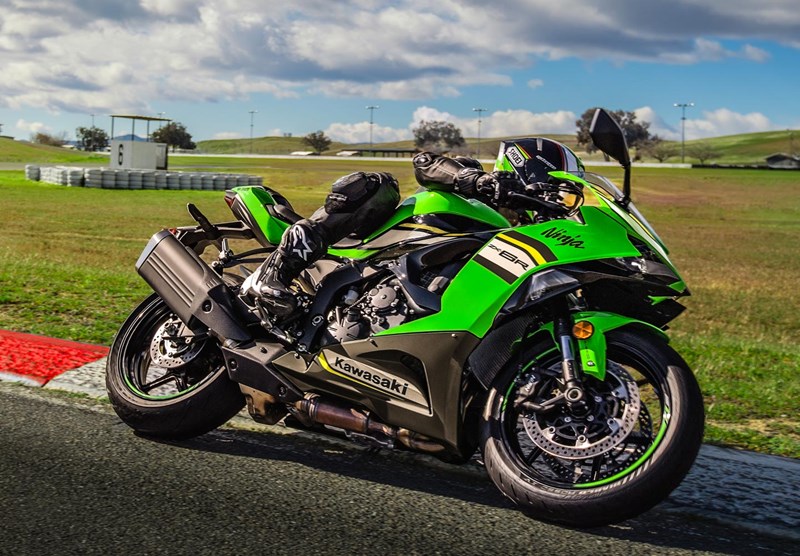
Engine and Performance
- Engine Type: 636cc, Inline-4, Liquid-Cooled, DOHC
- Power Output: Approx. 128 PS (94 kW) @ 14,000 rpm
- Torque: 70.8 Nm @ 11,000 rpm
- Bore x Stroke: 67 mm x 45.1 mm
- Compression Ratio: 12.9:1
- Fuel System: Digital Fuel Injection (DFI) with Dual Throttle Valves
- Cooling: Liquid-cooled
- Transmission: 6-speed constant mesh
- Top Speed: Approx. 260 km/h
- 0-100 km/h: Around 3.5-4 seconds (estimated)
Dimensions and Weight
- Overall Length: 2,085 mm
- Overall Width: 710 mm
- Overall Height: 1,125 mm
- Wheelbase: 1,405 mm
- Ground Clearance: 130 mm
- Seat Height: 830 mm
- Kerb Weight: Approx. 196 kg (wet weight)
- Fuel Tank Capacity: 17 liters
- Reserve Fuel Capacity: 4 liters (approx.)
Suspension and Brakes
- Front Suspension: 41mm USD (Upside-Down) forks, fully adjustable
- Rear Suspension: Horizontal Back-Link monoshock, fully adjustable
- Front Brakes: Dual 310mm discs with Nissin 4-piston radial calipers and ABS
- Rear Brakes: 220mm disc with single-piston caliper and ABS
- Braking System: Kawasaki Intelligent anti-lock braking system (KIBS), dual-channel ABS
- Wheel Size: 17 inches (front and rear)
- Tires:
- Front: 120/70-ZR17
- Rear: 180/55-ZR17
Electronics and Features
- Instrumentation: Full-color TFT display, with digital tachometer, gear position indicator, fuel gauge, and trip computer.
- Riding Modes: Multiple riding modes for different conditions (Sport, Road, and Rain), which adjust throttle response and traction control.
- Traction Control: KTRC (Kawasaki Traction Control), offering different levels of intervention for optimal stability and safety.
- Power Modes: Full Power and Low Power modes to tailor engine output to the rider’s preference and road conditions.
- Quickshifter: Standard up/down quickshifter for seamless gear shifts without using the clutch.
- LED Lighting: Full LED headlights, tail light, and turn signals for improved visibility and modern styling.
Performance and Handling
- Engine Performance: The 636cc inline-4 engine has long been the hallmark of the ZX-6R. It’s known for its high-revving nature, sharp throttle response, and smooth delivery of power. With 128 PS (94 kW) at 14,000 rpm, the ZX-6R delivers plenty of performance for the street and track, while 70.8 Nm of torque ensures a strong mid-range punch.
- Acceleration: The ZX-6R is capable of achieving 0-100 km/h in around 3.5 to 4 seconds, making it one of the quickest bikes in the 600cc class. The top speed of 260 km/h is impressive for a middleweight sportbike, providing a thrilling experience on highways and racetracks.
- Handling: The ZX-6R is renowned for its sharp handling and precise cornering. Thanks to the adjustable suspension setup, riders can fine-tune the bike’s performance for a variety of conditions, from smooth racetracks to twisty mountain roads. The lightweight chassis and aggressive geometry make it highly responsive, offering exceptional feedback to the rider.
- Braking: The Nissin radial calipers paired with dual 310mm front discs provide powerful and progressive braking performance. With KIBS (Kawasaki Intelligent Anti-lock Braking System), riders can enjoy enhanced braking stability even under heavy braking conditions, reducing the risk of wheel lock-up.
Comfort and Ergonomics
- Riding Position: The ZX-6R’s riding position is more aggressive than that of a naked bike, with slightly raised clip-on handlebars and rear-set footpegs. This positioning is designed to enhance aerodynamics and control during aggressive riding or track sessions, though it may feel a bit sporty for casual city commutes.
- Seat and Comfort: The seat is firm yet supportive, designed to hold the rider in place during high-speed cornering. However, it may not be the most comfortable for long-distance touring. As with most sportbikes, the emphasis is on performance rather than comfort for long rides.
- Foot Pegs and Handlebars: The footpegs are designed to optimize rider control during cornering, while the clip-on handlebars offer a more aggressive, forward-leaning posture, ideal for track riding or aggressive canyon carving.
Key Highlights of the Kawasaki ZX-6R
- 636cc Inline-4 Engine: The ZX-6R’s 636cc engine gives it a unique advantage in the middleweight sportbike category, offering better low- and mid-range torque than traditional 600cc machines, making it more accessible and usable for daily riding.
- Track and Street Performance: While it’s at home on the racetrack, the ZX-6R is surprisingly comfortable for street use as well, thanks to its manageable power delivery and modern tech features.
- Advanced Electronics: Features like Kawasaki Traction Control, Power Modes, and Quickshifter ensure that the bike is equipped with cutting-edge technology for superior safety and performance.
- Strong Braking System: With ABS and KIBS, the ZX-6R offers top-tier braking performance, essential for aggressive riding and track days.
- Aerodynamics: The aerodynamic design of the ZX-6R, with its sharp lines and integrated features, ensures excellent wind protection and stability at high speeds.
Pros of the Kawasaki ZX-6R
- Track-Ready Performance: The ZX-6R is a genuine track weapon, with exceptional power, handling, and braking. It’s a great choice for track-day enthusiasts.
- Kawasaki’s Engineering: As a member of the Ninja ZX series, the ZX-6R benefits from decades of engineering excellence in building sportbikes, ensuring that it performs at a high level.
- Advanced Tech: The riding modes, quickshifter, and traction control make the ZX-6R safer and more adaptable to different riding conditions.
- Strong Mid-Range Torque: The 636cc engine provides more low-end and mid-range power than typical 600cc inline-4 engines, making it more usable in a variety of riding situations.
- Agile and Responsive: The bike’s lightweight frame and sharp steering make it agile and highly responsive, offering great feedback to the rider.
Cons of the Kawasaki ZX-6R
- Comfort: The aggressive riding position may not be the best for long-distance touring or casual riders looking for more comfort.
- Price: The ZX-6R is on the pricier side compared to other middleweight sportbikes, making it less accessible for some riders.
- Limited Practicality: As a full-blown sportbike, the ZX-6R might not be the most practical option for daily commuting or casual weekend rides, particularly in heavy traffic.
5. Triumph Daytona 660 – Specifications and Features

Engine and Performance
- Engine Type: 660cc, Inline-3, Liquid-Cooled, DOHC
- Power Output: Approx. 95 bhp @ 10,250 rpm
- Torque: 64 Nm @ 6,250 rpm
- Transmission: 6-speed constant mesh
- Cooling: Liquid cooling
- Top Speed: Around 200 km/h (approximately)
- 0-100 km/h: ~3.5 seconds (estimated)
Electronics and Features
- Digital Instrument Cluster: Full-TFT display with gear position indicator, tachometer, fuel gauge, trip computer, and riding mode selector.
- Riding Modes: 2-3 different riding modes (Sport, Road, Rain), which adjust power output and throttle response to suit different conditions.
- Triumph Traction Control: Multiple levels of traction control to enhance stability, especially in wet or low-traction conditions.
- LED Lighting: Full LED headlights, tail light, and turn indicators for improved visibility and modern design.
- Quickshifter: Standard on the Daytona 660, allowing for seamless upshifts without the need for a clutch.
- Assist and Slipper Clutch: Reduces clutch effort and helps prevent rear-wheel lockup during aggressive downshifting.
Performance and Handling
- Engine Performance: The 660cc inline-3 engine offers a unique character in the middleweight sportbike segment. Unlike the typical inline-4, the triple engine provides a torque-rich powerband that makes the Daytona 660 not only fun to ride on the track but also usable in daily conditions. It delivers smooth power, especially in the lower rev range, but with a thrilling mid-range punch as the engine reaches higher rpm.
- Acceleration: With 118 PS (87 kW) at its disposal, the Daytona 660 is a potent machine in its class, offering impressive acceleration and straight-line performance. It can easily accelerate from 0-100 km/h in approximately 3.5 seconds, making it more than fast enough for the road and track.
- Handling: The Daytona 660 features a lightweight chassis, allowing for exceptional agility and responsive handling, both on tight corners and fast straights. With an adjustable suspension setup at both ends, it caters to a range of riders, from those looking for a more aggressive setup for the track to a more comfortable setup for long-distance touring.
- Braking: Equipped with Brembo 4-piston radial calipers and dual 310mm discs up front, the Daytona 660 offers superb braking power and feel, ideal for aggressive riding and track days. The ABS system ensures safety in tricky conditions, particularly during hard braking.
Ergonomics and Comfort
- Riding Position: The Daytona 660 maintains the classic sportsbike posture, with slightly raised clip-on handlebars for a more neutral, upright position compared to more aggressive race-oriented models. The 810mm seat height is relatively accessible for a range of riders, and the bike’s lightweight construction contributes to a comfortable riding experience.
- Comfort for Long Rides: While the bike is designed primarily for track use, the ergonomics are surprisingly comfortable for longer street rides. The seat padding is firm yet supportive, and the overall riding posture is designed for a blend of agility and long-distance comfort.
Key Highlights of the Triumph Daytona 660
- Unique Inline-3 Engine: The 660cc, inline-3 engine offers an exciting mix of power and torque, with a distinctive sound and feel that’s different from the typical inline-4.
- Track-Ready Performance: With a quickshifter, Brembo brakes, and adjustable suspension, this bike is more than capable of handling track days and spirited riding on twisty roads.
- Modern Electronics: The ride-by-wire throttle, multiple riding modes, and traction control systems help adjust the bike’s performance to the rider’s skill level and weather conditions.
- Brembo Brakes: The bike’s top-notch Brembo braking system gives riders exceptional confidence in high-performance and emergency braking scenarios.
- Sporty Design: The sharp, aerodynamic bodywork and full LED lighting give the Daytona 660 an aggressive, modern look that will turn heads.
- Affordability: Positioned as a middleweight sportbike, the Daytona 660 offers premium performance at a competitive price, making it a great option for enthusiasts looking to enter the middleweight sportbike category.
Pros of the Triumph Daytona 660
- Unique Engine Character: The inline-3 engine gives it a unique performance signature with smooth delivery and a different feel compared to traditional 4-cylinder bikes.
- Track and Street Performance: Well-balanced for both track days and daily street use, with modern features that enhance versatility.
- Premium Components: With Brembo brakes, an assist and slipper clutch, and Triumph’s electronic aids, this bike punches well above its weight in terms of technology and quality.
- Modern and Stylish Design: Sharp aesthetics and LED lighting make the bike stand out in a crowded market.
Cons of the Triumph Daytona 660
- Limited Dealer Network: While Triumph has improved its presence in India, its dealer network and service centers are still more limited compared to Japanese brands, which might affect ease of maintenance in some regions.
- Not as Refined as Higher-End Models: While the Daytona 660 offers excellent performance, it’s still a middleweight bike and doesn’t have the same high-end features as premium bikes like the Daytona 765 or Yamaha R1.
- Price: The price is on the higher side for this segment, which could make it a stretch for some riders when compared to direct rivals from Japanese brands.
